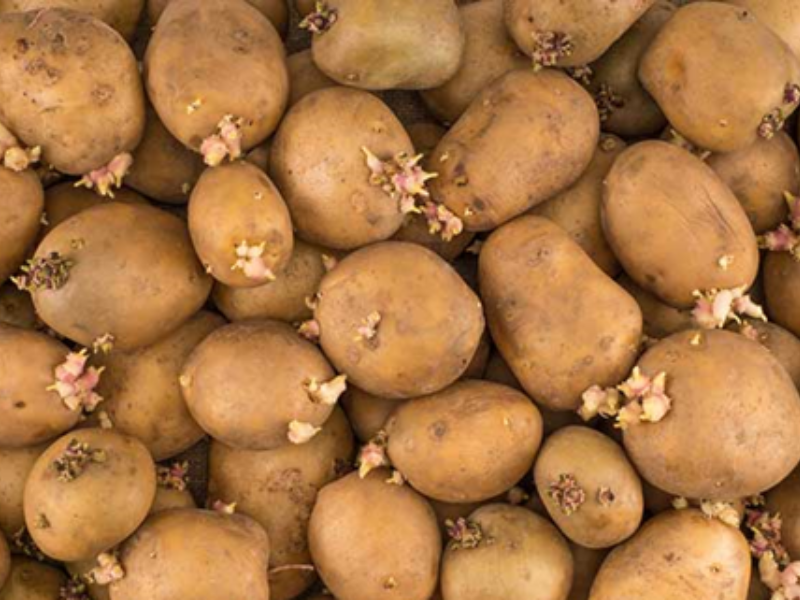2025.12.09
The potato (Solanum tuberosum) is one of the most beloved culinary ingredients, appearing in various forms in our meals, from crispy french fries and chips to hearty mashed potatoes and diverse home-cooked dishes. Not only is it a favorite among adults, but children also adore its taste and flavor. The greening and sprouting of potatoes is a common occurrence during storage, raising the question for many whether consuming sprouted potatoes is harmful to health.

The Reason Behind Potato Sprouting
The greening and sprouting of potatoes are a natural part of their growth cycle, indicating their readiness to grow into a new plant. The potato is actually a modified stem of the plant, containing colorless organelles called amyloplasts in its tissues. Their function is to store the plant's food in the form of starch. When potatoes are not stored in suitable conditions, meaning exposure to sunlight or other light sources and humid places, the dormant buds on the potato, commonly referred to as "eyes," become active and ready to grow. In these conditions, the potato's amyloplasts transform into organelles called chloroplasts, responsible for photosynthesis. In response to light, they increase the production of the green pigment chlorophyll, causing the skin and some of the potato's flesh to turn green. In addition to increased chlorophyll production, under growth conditions, the potato increases the production of a toxic nitrogen-containing compound called solanine as a natural defense mechanism against pests and diseases. Therefore, while chlorophyll is a harmless chemical, the presence of the green color resulting from it indicates that the tubers have also increased the production of a colorless compound called solanine.
Solanine
This compound is present in all parts of the potato plant, but its concentration is significantly higher in sprouted or green potatoes. Solanine contributes to the plant's defense mechanisms, but it is toxic and its excessive consumption is harmful to humans. High consumption of solanine can cause nausea, vomiting, diarrhea, and in severe cases, neurological symptoms such as headaches, dizziness, and confusion.
Sprouted Potatoes and Diabetes
In addition to its toxicity, consuming sprouted potatoes is not suitable for diabetics or those concerned about their blood sugar levels. This is because when a potato sprouts, its starch content is converted to sugar, resulting in sprouted potatoes causing a more rapid increase in blood sugar levels compared to fresh potatoes.
Sprouted Potatoes and Pregnancy
Some recent studies suggest that consuming sprouted potatoes during pregnancy may lead to various developmental problems in the fetus and increase the risk of birth defects.
Nutritional Changes in Sprouted Potatoes
When a potato begins to sprout, it utilizes its stored nutrients to provide the energy needed for the growth of new sprouts. This process leads to a decrease in the carbohydrate and vitamin C content of the tuber, generally reducing its nutritional value. However, even with this reduction in nutritional value, sprouted potatoes can still provide some nutrients like vitamin C and B6, potassium, and fiber.
Safety of Consuming Sprouted Potatoes
The safety of consuming sprouted potatoes depends on the extent of discoloration, greening, and sprouting. If the potato is soft, wrinkled, or has an unpleasant odor, it should be discarded as these are signs of spoilage. If the potato is firm and the sprouts are small, the sprouts and green or discolored parts can be carefully removed, and the potato can be peeled. This makes the consumption of the potato safer due to the higher concentration of toxic compounds in the sprouts and skin. Boiling, baking, or frying potatoes at high temperatures can also reduce the level of toxins but does not eliminate them completely.
Preventing Potato Sprouting
To prevent potatoes from sprouting, the first step is to store them in dry, cool, and dark places. It is also recommended not to store potatoes and onions together, as onions produce ethylene gas, which accelerates the ripening process and can cause rapid rotting and spoilage of nearby potatoes. This gas also accelerates the sprouting of potatoes. The best temperature for storing potatoes is between 7 and 10 degrees Celsius, which is lower than room temperature and higher than refrigerator temperature. Also, avoid storing potatoes in the refrigerator, as cold temperatures can cause some of the potato's starch to convert to sugar, leading to an unpleasant taste and browning during cooking.


